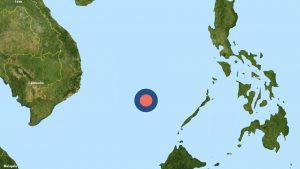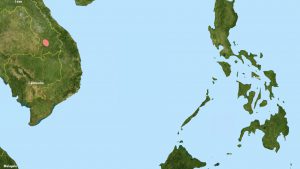Miracles of the Mid-Pleistocene Transition, Part 4
A little more than a year ago, I wrote a three-part series on the miracles of the Mid-Pleistocene transition (MPT).1 The blog posts told the story of all the amazing events that simultaneously occurred to transition our ice age cycle from a 41,000-year periodicity to an approximately 100,000-year periodicity (see figure 1). New research shows that two impacts sites possibly emanating from the same cometary source may be responsible for a cloud of debris that played a significant role in bringing about the MPT.

Figure 1: Ice Age Cycle Transition. Diagram credit: Hugh Ross
Antarctic ice cores and a sedimentary core offshore from New Zealand show that this transition occurred about 800,000 years ago (see figure 1). This transition date corresponds with two other major events:
- Australasian and Western Canadian impact tektites
- Brunhes-Matuyama magnetic reversal
Using high-resolution argon-40 to argon-39 isotope ratios, a team of ten geophysicists established a date for the impact tektites: 785,000±7,000 years ago.2 Four independent teams of geophysicists determined the date for the Brunhes-Matuyama magnetic reversal to be 780,000±8,000 years ago.3 As demonstrated by physicist Richard Muller, a major impactor striking Earth at an oblique angle has a high probability of generating a magnetic reversal a few hundred to a few thousand years following the impact.4
Source of the Australasian Tektites
One of the extraordinary events I previously wrote about that likely played a significant role in the MPT was a huge dust cloud ejected into interplanetary space as a consequence of the major impact event that occurred 0.79 million years ago. In the second post I described how four geophysicists, led by Aaron Cavosie, analyzed a large, diverse sample of Australasian tektites.5 Australasian tektites are drops of siliceous impact melt found in an area that measures about 8,000 kilometers by 13,000 kilometers. This area covers most of Southeast Asia and Australia and large parts of both the Indian and Pacific Oceans.
Cavosie’s team calculated that the quantity and extent of Australasian tektites, if caused by a single impact, would result in an impact crater at least 40 and as much as 100 kilometers in diameter (25–60 miles in diameter). They determined that the location of this crater must be located somewhere in Southeast Asia.
In 2018, mathematician Hermann Burchard claimed that the atolls of the Spratly Archipelago in the South China Sea is the impact crater responsible for the Australasian tektites (see figure 2). His calculations were consistent with a comet “obliquely coming from the SW at an extremely shallow angle, striking the Sunda shelf yet unexploded with the shock of its compressed bow wave, and causing the continental shelf and slope to collapse.”6 He then showed how the collapse could produce the fault system observed in the area, the Brunhes-Matuyama magnetic reversal, the atolls of the Spratly Archipelago, and a powerful ejection of tektites.7

Figure 2: Spratly Islands Crater Site. The estimated crater size for the Spratly Islands site is between 40 kilometers in diameter (pink circle) and 100 kilometers in diameter (dark blue circle), assuming it is the only impact site. Diagram credit: Hugh Ross
A team of eleven geologists led by Kerry Sieh published additional evidence for a huge impactor striking Southeast Asia 0.79 million years ago.8 They presented four lines of evidence indicating that an impact crater likely lies about a hundred meters beneath lavas of a young volcanic field (much younger than 0.7 million years) in southern Laos (see figure 3). Sieh’s team’s measurements affirmed that the impact angle was shallow, only about 10°. The team also affirmed that such a shallow impact angle by such a large impactor would have produced a powerful ejection of tektites.

Figure 3: Southern Laos Crater Site. The crater size for the Southern Laos site (pink ellipse) as determined by measurements of the local gravitational anomaly is 17 kilometers by 13 kilometers. Diagram credit: Hugh Ross
Australasian Tektites and the MPT
If the impactor was a large comet, it could have split into two or more pieces as it encountered Earth’s atmosphere. Hence, the same impactor could have produced both the Spratly Islands and southern Laos craters and possibly other craters. Multiple impact sites would have more broadly distributed the tektite cloud. Such an outcome would have produced an exceptionally large cloud of tektites enshrouding Earth’s atmosphere as well as an interplanetary cloud of tektites.
The Earth-enshrouding tektite cloud would have dramatically cooled Earth’s surface. As explained in my three previous blog posts, such cooling, whatever the sources, definitely played a crucial role to bringing about the MPT.9 As Burchard explains in his paper,10 Earth passing through an interplanetary tektite cloud approximately every 100,000 years would provide an additional role in bringing about the MPT.
Significance of the MPT
As I explained briefly in chapter 15 of Improbable Planet11 and in much more detail in chapter 13 of my soon-to-be-released book, Weathering Climate Change,12 without the MPT there would be no possibility of a large human population or of global high-technology civilization. It takes a large human population and global high-technology civilization to enable billions of humans, within just several thousand years, to learn of the Creator’s message to humanity, including his offer of redemption.
Thanks to the research discoveries described here, we now know that a highly fine-tuned large impact event played an important role in the MPT—that is, in transitioning the ice age cycle from a 41,000-year periodicity into an approximately 100,000-year periodicity. The latest discoveries and research on the MPT affirm a principle repeatedly declared or implied in the Bible’s wisdom books (Job, Psalms, Proverbs, Ecclesiastes). That principle: the more we learn about nature, the more evidence we will find for the supernatural handiwork of God in designing the natural realm for the specific benefit of human beings.
Check out more from Reasons to Believe @Reasons.org
Endnotes
- Hugh Ross, “Miracles of the Mid-Pleistocene Transition, Part 1,” Today’s New Reason to Believe (blog), Reasons to Believe, October 1, 2018, https://reasons.org/explore/blogs/todays-new-reason-to-believe/read/todays-new-reason-to-believe/2018/10/01/miracles-of-the-mid-pleistocene-transition-part-1; Hugh Ross, “Miracles of the Mid-Pleistocene Transition, Part 2,” Today’s New Reason to Believe (blog), Reasons to Believe, October 8, 2018, https://reasons.org/explore/blogs/todays-new-reason-to-believe/read/todays-new-reason-to-believe/2018/10/08/miracles-of-the-mid-pleistocene-transition-part-2; Hugh Ross, “Miracles of the Mid-Pleistocene Transition, Part 3,” Today’s New Reason to Believe (blog), Reasons to Believe, October 15, 2018, https://reasons.org/explore/blogs/todays-new-reason-to-believe/read/todays-new-reason-to-believe/2018/10/15/miracles-of-the-mid-pleistocene-transition-part-3.
- Winfried H. Schwarz et al., “Coeval Ages of Australasian, Central American, and Western Canadian Tektites Reveal Multiple Impacts 790 ka Ago,” Geochimica et Cosmochimica Acta 178 (April 1, 2016): 307–19, doi:10.1016/j.gca.2015.12.037.
- Bassam Ghaleb et al., “Timing of the Brunhes-Matuyama Transition Constrained by U-Series Disequilibrium,” Scientific Reports 9 (April 15, 2019): id. 6039, doi:10.1038/s41598-019-42567-2; Xianghui Kong et al., “Asynchronous Records of Brunhes/Matuyama Reversal in Marine Sediments and Chinese Loess: Review and Discussion,” Quaternary International 319 (January 2014): 137–42, doi:10.1016/j.quaint.2013.08.001; Brad S. Singer et al., “Structural and Temporal Requirements for Geomagnetic Field Reversal Deduced from Lava Flows,” Nature 434 (March 31, 2005): 633–36, doi:10.1038/nature03431; X. Quidelleur et al., “The Age and Duration of the Matuyama-Brunhes Transition from New K-Ar Data from La Palma (Canary Islands) and Revisited 40Ar/39Ar Ages,” Earth and Planetary Science Letters 208 (March 30, 2003): 149–63, doi:10.1016/S0012-821X(03)00053-0.
- Richard A. Muller, “Avalanches at the Core-Mantle Boundary,” Geophysical Research Letters 29, no. 19 (October 12, 2002): 41-1 to 41-4, doi:10.1029/2002GL015938.
- Aaron J. Cavosie et al., “New Clues from Earth’s Most Elusive Impact Crater: Evidence of Reidite in Australasian Tektites from Thailand,” Geology 46, no. 3 (December 20, 2017): 203–206, doi:10.1130/G39711.1.
- Hermann G. W. Burchard, “Spratlies Archipelago as the Australasian Tektite Impact Crater, Details of Formation and Richard Muller’s Dust Cloud Explanation for the Mid-Pleistocene Ice Age Cycle Transition,” Open Journal of Geology 8, no. 1 (January 15, 2018): 1, doi:10.4236/ojg.2018.81001.
- Burchard, “Spratlies Archipelago,” 1–8.
- Kerry Sieh et al., “Australasian Impact Crater Buried under the Bolaven Volcanic Field, Southern Laos,” Proceedings of the National Academy of Sciences USA 117, no. 3, (January 21, 2020): 1346–53, doi:10.1073/pnas.1904368116.
- Ross, “Miracles of the Mid-Pleistocene Transition, Part 2.”
- Burchard, “Spratlies Archipelago,” 1–8.
- Hugh Ross, Improbable Planet: How Earth Became Humanity’s Home (Grand Rapids: Baker, 2016), 198–215.
- Hugh Ross, Weathering Climate Change: A Fresh Approach (Covina, CA: RTB Press, 2020), forthcoming.





